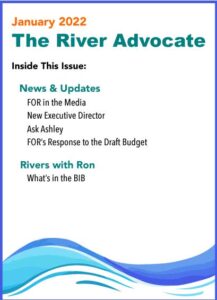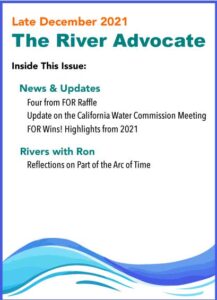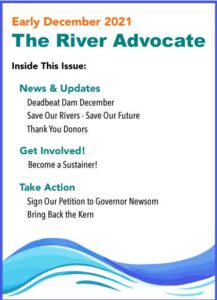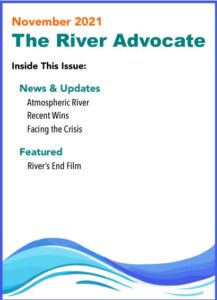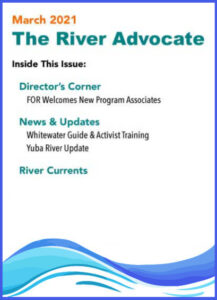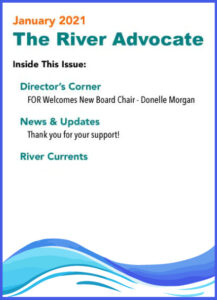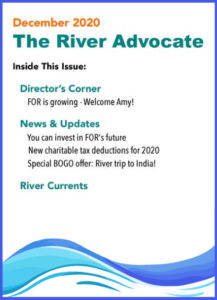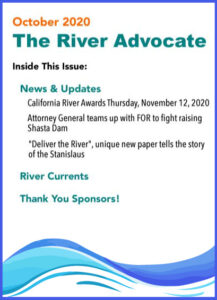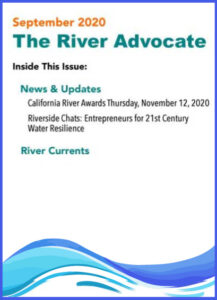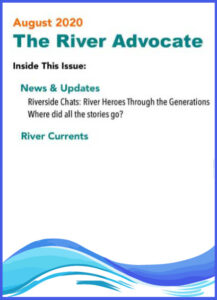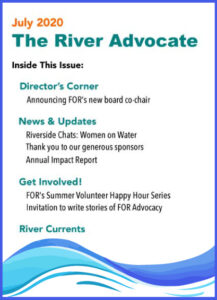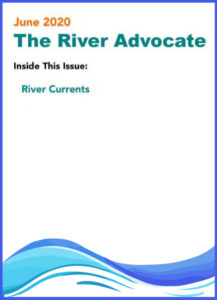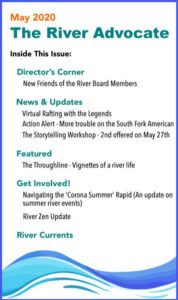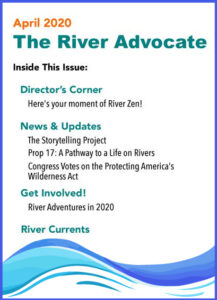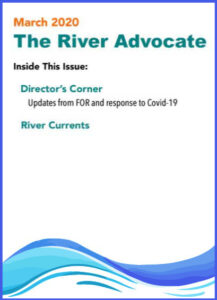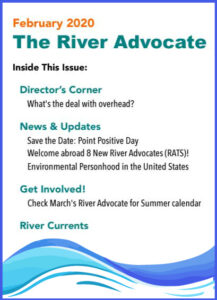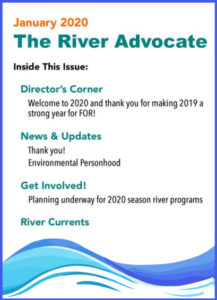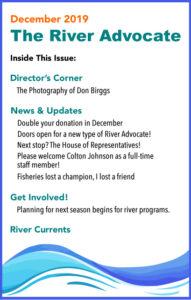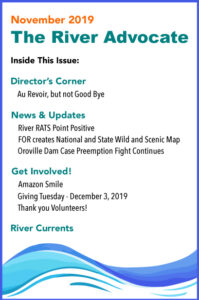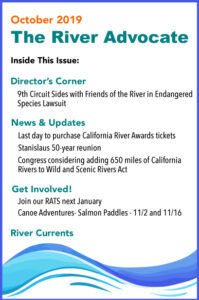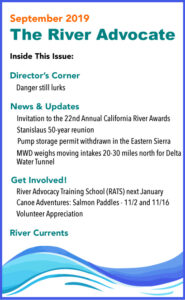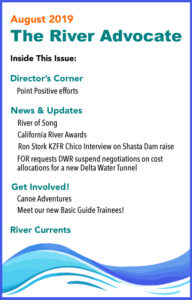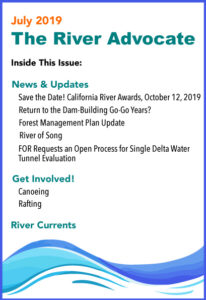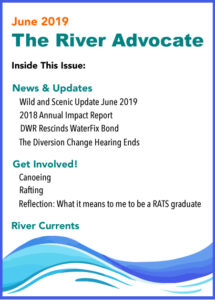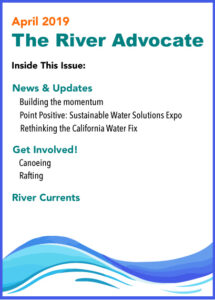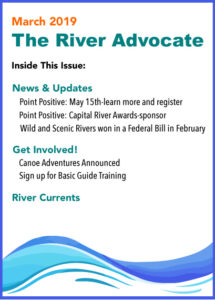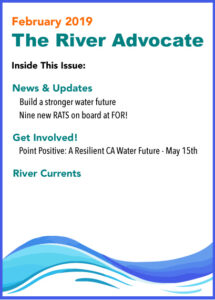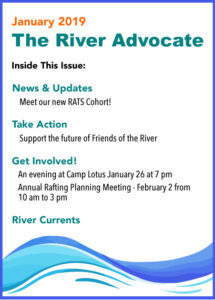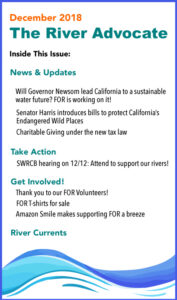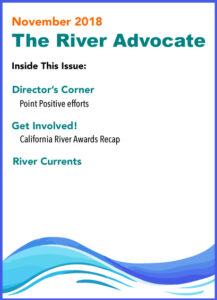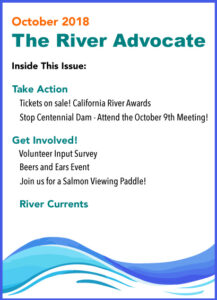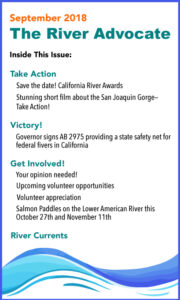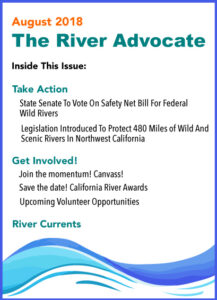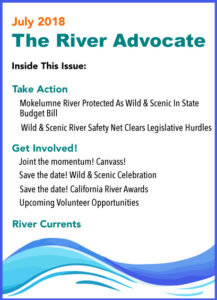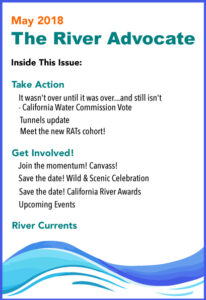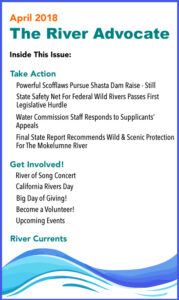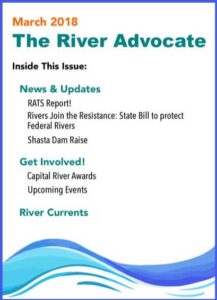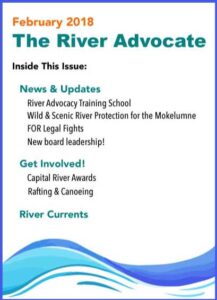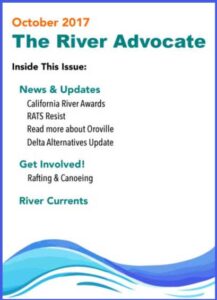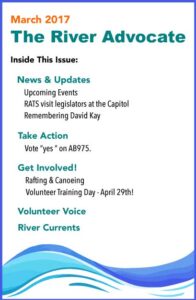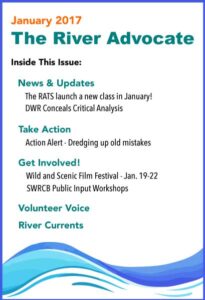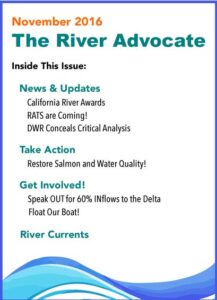In this issue:
October 2022
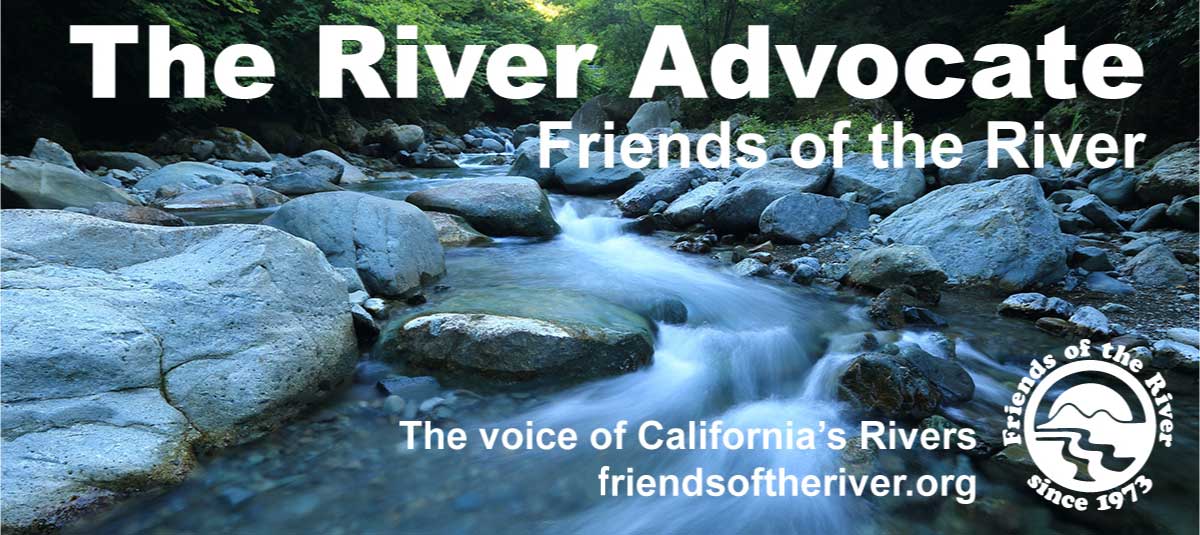
Currents: Victories and Threats
by Jann Dorman, Executive Director
Protecting Flows on the South Fork American
 The South Fork of the American River (SFA) is a California state treasure. However, the El Dorado Irrigation District (EID) proposes to add a new point of diversion to their Water Right Permit 21112, which threatens flows on the South Fork American River immediately downstream of Kyburz to Folsom Reservoir. Currently, under this permit EID diverts 17,000-acre feet annually at Folsom Reservoir the lowest elevation within their service area. Now EID is proposing to move the diversion to an upstream location, at the existing El Dorado Diversion Dam near Kyburz. Between Kyburz and Folsom Reservoir, there are over 50 miles of whitewater recreation opportunities for the many visitors who annually spend their money on El Dorado County businesses. An estimated 80,000 people floated the sections between Chili Bar and Salmon Falls in 2021, according to the El Dorado County River Management Plan report. These visitors, in addition to the many visitors who enjoy access to the river for picnicking, hiking, camping and fishing come from all over the California, throughout the United States, and the world. This threat to the SFA is a threat for everyone in California.
The South Fork of the American River (SFA) is a California state treasure. However, the El Dorado Irrigation District (EID) proposes to add a new point of diversion to their Water Right Permit 21112, which threatens flows on the South Fork American River immediately downstream of Kyburz to Folsom Reservoir. Currently, under this permit EID diverts 17,000-acre feet annually at Folsom Reservoir the lowest elevation within their service area. Now EID is proposing to move the diversion to an upstream location, at the existing El Dorado Diversion Dam near Kyburz. Between Kyburz and Folsom Reservoir, there are over 50 miles of whitewater recreation opportunities for the many visitors who annually spend their money on El Dorado County businesses. An estimated 80,000 people floated the sections between Chili Bar and Salmon Falls in 2021, according to the El Dorado County River Management Plan report. These visitors, in addition to the many visitors who enjoy access to the river for picnicking, hiking, camping and fishing come from all over the California, throughout the United States, and the world. This threat to the SFA is a threat for everyone in California.
Ironically, two decades ago, El Dorado County Water Agency on behalf of EID made the decision to divert water at only Folsom Reservoir. Basically, they made this commitment to protect recreational and environmental concerns on the South Fork American River in exchange for opposition groups to drop protest of water right 21112 before the State of California. Now it seems we need to remind the current EID Board and staff of that same commitment today.
El Dorado Irrigation District has filed a Notice of Preparation with the State Water Resources Control Board for an Environmental Impact Report (EIR) and the public had an opportunity to comment on what should be included in the DRAFT EIR. Thank you to everyone who responded to our Action Alert a few weeks ago and sent comments to the EID. EID has said they will issue the DRAFT EIR sometime in the summer of 2023. We will all be ready when they do.
Colorado River – Federal Intervention?

While the collaborative process between the participating states of the Colorado River Compact has resulted in some agreements to reduce diversions, the reality is that the Colorado river remains disastrously over allocated. On October 28, 2022, the US Department of the Interior (DOI) issued a press release with a thinly veiled warning to the basin states. Reclamation will publish a Notice of Intention (NOI) to prepare a Supplemental Environmental Impact Statement (SEIS), which will include proposed alternatives to revise the December 2007 Record of Decision associated with the Colorado River Interim Guidelines. What does that wonky language mean? The NOI outlines that, in order to ensure that Glen Canyon Dam and Hoover Dam continue to operate, Reclamation may need to modify current operations and reduce downstream releases from both dams. What this means is that the 4 million acre/feet allocated to California may be cut further, in the next year or so. The Colorado River is a major component of Southern California’s water supply. Thus, such cutbacks will likely create further political pressure to dam and divert California rivers. The beloved and iconic Colorado river is under threat. The DOI used the word “dire” in its press release. How the Colorado river water is allocated will have huge impact in California. Friends of the River will continue to closely follow events in the Colorado river basin.
Rendezvous by the River
by Jann Dorman, Executive Director
 The moon rose over the river, the people came, and the Rendezvous was beautiful. Thank you to all of you “friends” of the river, and friends of each other who made the evening so much fun. Over 200 people from near and far came together to celebrate and renew a sense of community. Since the pandemic began, this sense of community is extremely important in maintaining momentum in our work.
The moon rose over the river, the people came, and the Rendezvous was beautiful. Thank you to all of you “friends” of the river, and friends of each other who made the evening so much fun. Over 200 people from near and far came together to celebrate and renew a sense of community. Since the pandemic began, this sense of community is extremely important in maintaining momentum in our work.
We are so grateful to our sponsors: A-Total Fire Protection, All Outdoors, American Kitchen Cabinets, American River Resort, American Whitewater Expeditions, ARTA River Trips, Camp Lotus, Doug Stadler, Jennifer Jennings & Michael Bledsoe, Marco’s Café, Mother Lode River Center, OARS, River Runners, Sun Power, Tributary Whitewater Tours, Tuolumne River Outfitters, and Whitewater Excitement. Please support these companies, as they support our rivers.

The wine was flowing thanks to Lava Cap, Chappellet, and Convergence. The setting was magnificent thanks to the moon, Camp Lotus and over 20 volunteers. The music and food were hot thanks to the Street Wheelers, Diane Wilkinson and so many more.
Thanks to everyone who contributed in a wide variety of ways, Friends of the River was able to raise close to $30,000. These funds go directly into fighting for the rivers you care about. We are so grateful for the generosity of the river community. However, we have more to ask of you. We need you to reach out to your friends and networks to encourage them to join you in saving rivers. Ask them to join FOR at any contribution amount (although more is better.) The larger our base of supporters, the more impact your dollars will have on the environment. Join FOR today.
November Wild and Scenic River Anniversaries
by Ron Stork, Senior Policy Advocate

November is another month when the U.S. Congress often wraps up its work, so November is another busy wild & scenic river anniversary month.
First, a setting for three of the anniversaries. After the big win on the Tuolumne River and passage the big California federal wilderness bill in 1984, the first round of U.S. Forest Service forest plans (as well as the Bureau of Land Management’s) were emerging. These were the first plans where the federal agencies embraced their independent responsibilities under §5(d) of the National Wild & Scenic Rivers to undertake wild & scenic river studies as part of their land use plans. Friends of the River and colleagues were working these plans — and responding to some of the threats and opportunities with our “Three Rivers Campaign,” which bore fruit 35 years back.

Merced River, November 2, 1987 — The first river added to the national wild & scenic rivers system in this campaign was a good deal of the Merced River — from the headwaters of the Merced and its South Fork downstream to Briceburg (where Highway 140 begins its journey up river eventually entering the languid reaches of Yosemite Valley).
At the time, there was a couple of ambitious wannabe dam plans gathering dust on the shelves of some local governments, but what really stirred things up was a series of proposed diversion dams along the main stem of the Merced starting in El Portal at the Yosemite National Park boundary. These were real proposals, active, and in the early stages of seeking approvals from federal regulators.
Folks organized. I mean really organized.

By this time the Sierra National Forest, Yosemite National Park, and the Bureau of Land Management had prepared a draft wild & scenic river assessment recommending that the river be designated down to “Lake” McClure Reservoir. The area’s Congressman, Tony Coelho (D-Merced/Dos Palos), and California’s two U.S. Senators came together to carry the required legislation, albeit pruning off the river at Bagby. California Republican Senator Pete Wilson and Representative Robert Lagomarsio (R-Long Beach) made this a bipartisan effort. President Ronald Reagan, himself a Californian Republican, did the honors with his signature.
When then House Majority Whip Tony Coehlo stepped down from his seat a few years later, a radio interviewer asked him what legislative accomplishment he was most proud of. Tony was quick to reply: saving the Merced River.
And just not to leave you hanging, as I reported in the previous River Advocate, five years later (after satisfying some of Mariposa County’s concerns with a small water project) Congress would add that pruned-off river segment into the national system (Bagby to Lake McClure Reservoir).
By wild and scenic river campaign standards, the campaign had been a short one: only 15 years or so.
Kings River, November 3, 1987 — The Kings is a big river. And it’s wild. It’s Middle and South Forks emerge from the granite canyons of Kings Canyon National Park, and their junior and somewhat reservoir-tamed cousin, the North Fork, the latter arising in the John Muir and Dinkey Creek Wilderness Areas of the Sierra National Forest. Gathered together, the river is an impressive spring/early summer piece of boatable whitewater — at least until it disappears into the still waters of Pine Flat Reservoir.
The controversies around the creation of Kings Canyon National Park in 1940 and its 1965 additions were a lot about foreclosing water projects proposed by many — as well as protecting some of the finest high-elevation backpacking country in the Sierra Nevada. But still unprotected, just downstream of the Park as it exists today, lay the calmer whitewater that could be inundated by a dam called Rogers Crossing.
By 1963, the Rogers Crossing dam proposal had gone “local,” becoming a focus of the Kings River Water Users Association and the Kings River Conservation District. Over the next 24 years, the proposed 500 to 600 foot-tall dam was engineered back and forth, with the interest waxing and waning depending on the dam’s modeled moneymaking potential. But by the early 1980s the engineers’ work had grown publicallypublicly visible enough to spark a campaign — an impressive campaign.
Cue the federal government. The draft Forest Plan, with concurrence from the National Park Service, found the South and Middle Forks and the main stem upstream of Pine Flat to be eligible for inclusion in the national wild & scenic river system. The draft Forest Plan even recommended the Forest and National Park river reaches upstream of the proposed Rogers Crossing reservoir for designation. But the question of the river’s continuing vulnerability to the Rogers Crossing dam was being left to the politicians.
Rep. Richard Lehman (D-Fresno) took up the challenge with the support of California’s U.S. Senators Cranston and Wilson. Leading the opposition was Rep. Chip Pashayan (R-Fresno). Sparks flew. The result was a compromise of sorts: upstream of the proposed reservoir, wild & scenic; in the proposed reservoir, Congress (not the Federal Energy Regulatory Commission) would have to approve the dam. Oh, and that downstream “protected” segment was pruned a bit to end 15 vertical feet above Pine Flat Reservoir.
Five years later, as reported in last month’s River Advocate, the California legislature, would quietly remove the long-expired Kings River dam-building moratorium added by an earlier generation, then led by State Senator George Zenovich (D-Fresno). Congress had done its work to extinguish the threat to the centerpiece of the mighty Kings River canyon, and the legislature rested on that.
Oregon Scenic Waterways Act, November 3, 1970 — The “big idea” of the National Wild & Scenic Rivers Act was only two years and a day old when the State of Oregon created its own state wild & scenic rivers act via a citizen-initiated statewide ballot measure (Measure 9), which passed with more than 65% of the vote.
Good work, Oregon voters. It took the California legislature another two years before California created its system.
Klamath River just upstream of California, November 8, 1988 — And speaking of the Oregon Scenic Rivers Act, on the eighth of November, eighteen years later, an eleven-mile segment of the Klamath River below the J.C. Boyle Powerhouse and reaching downstream to the Oregon border with California (along with 10 other rivers) was added to the Oregon wild & scenic river system.
With the pending removal of Pacificorp’s Copco 1 & 2 and Iron Gate Dams, the Oregon wild & scenic river segment, the restored river, and California’s Klamath state (and federal) wild & scenic river downstream will be continuous. And when J.C. Boyle Dam and Reservoir are removed, these segments would be continuous with many more free-flowing but unprotected river miles upstream until Pacificorp’s Keno and the U.S. Bureau of Reclamation’s Link Dams once again interrupt the flow of the Klamath.
Perhaps there is undone work still be accomplished by this generation of river savers.
Just thinking out loud.
North Fork American River, November 10, 1978 — This river was designated the old-fashioned way — after a Congressionally mandated study. The study bill was signed on January 3, 1975 by President Gerald Ford, the designation bill by President Jimmy Carter. The measure had been championed by Rep. Biz Johnson (D-Roseville) and California U.S. Senator Alan Cranston.
The geography of the bill, like the earlier state wild & scenic river designation in 1972, had been carefully fashioned to not occupy the American River canyon that was part of the federally authorized Auburn Reservoir, behind the proposed giant Auburn dam. Politics, of course, but the North Fork upstream of the proposed reservoir is an amazing piece of Sierran whitewater. Yep, class V in places.
The late Matt Bailey was the instigator-in-chief for this multi-year effort. I hope that there is much history in the files that he donated to a local university — a history that needs to have a historian to tell the story of this successful but now somewhat forgotten campaign.
Smith River, November 16, 1990 — The Smith River is tucked away in the northeast corner of the state, and is the only one of the state’s wild & scenic rivers that goes from its headwaters (well, stay tuned a little) to the sea without encountering a dam. Its clear waters are legendary, but the Smith is only a household word to a few in this state, so it is befitting that the Smith’s 1990 designation was a quiet campaign.
The Smith River was one of the original state wild & scenic rivers, and its designation was experimental — all of its tributaries were included in the designation. A decade later, the legislature would prune 2,760 miles of forks, creeks, and drainage courses away. It had been federally designated by the Governor to Secretary of the Interior (2(a)(ii)) route in 1982, but since much of the land was federal and 2(a)(ii) are supposed to be managed by the state, that had created ambiguities in management.
The solution was simple: Congressionally redesignate the river within the national forest (to wild & scenic river insiders, the 3(a) route). To recreate the watershed level designation of the National Forest, the Smith River’s watershed within the national forest in California became the Smith River National Recreation Area.
The Congress was willing, passed the bill on November 9, 1990, and President George H.W. Bush signed the legislation a week later.
But coming back to this story, on May 4, 2021, Oregon’s U.S. Senators Merkley and Wyden introduced S. 1538, the Smith River National Recreation Area Expansion Act, to add 58,000 acres of the North Fork Smith watershed in Oregon to the existing Smith River National Recreation Area in California. The bill would also contain 74 miles of new wild & scenic river designations. California’s U.S. Senators Feinstein and Padilla are cosponsors.
And yes, many of the Friends of the River old-timers know the cast of Smith River activists working then and working now. Hopefully, we all can someday celebrate another anniversary.

NF & SF Kern, November 24, 1987 – The Kern was the last of Friends of the River’s “Three Rivers Campaign.” November 1987 was a successful month. This river was also one that emerged the old-fashioned way, as a Congressionally designated study river with a report to the Congress.
Of course, sometimes accidents happen along the way. During the House of Representatives hearings on the North Fork Kern, the subcommittee chair, John Seiberling (D-Ohio), seemed to remember that the world-famous photographer Ansel Adams had written him a letter urging him to add the “South Fork” to the system. The Forest Service draft forest plan had found the South Fork Kern to be eligible for designation and thus did not object, so the subcommittee added the South Fork Kern (within the National Forest), and that’s the way the bill was signed by President Ronald Reagan.
The Congressional hearings had been rather civil. Part of the campaign had been tougher, including death threats against Friends of the River staff. Today, though, the kerfuffles of the campaign have faded for many, hopefully. But unless House Speaker heir apparent Rep. Kevin McCarthy decides to embrace designation of parts of the “lower Kern,” it’s going to take some time before we can have another Kern River anniversary.
River Advocate Back Issues
September 2022
Back Issues of Headwaters Newsletter

